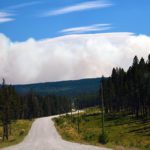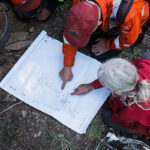Home »

Mercury is visible until Jan. 31
By Richard Nowell
Mercury will be visible in the evening sky this week until Jan. 31.
On Sunday, January 24, Mercury reached its greatest eastern elongation of 18.6 degrees from the Sun and was at its highest point above the horizon in the evening sky.
Look above the horizon in the west-southwest direction. If you have a compass, its bearing is about 250 degrees. Or use a smart phone app like Stellarium to locate it.
Mercury can be difficult to find at our northern latitudes in Canada, wait until 6:15 or 6:30 p.m., about an hour after the Sun sets and the blue glow on the western horizon fades and it gets dark. But don’t wait too long, since it will set below the horizon by 7 p.m.
It’s bright enough to see with the eye, it’s about as bright as Canopus, the second brightest star in the sky. A pair of binoculars are useful to identify it as a disc. (The usual caution: never look at the Sun with binoculars since that will blind you.) If you’re ever on a holiday near the equator, Mercury is much easier to see there during elongations.
Note: An astronomy term used here is elongation. When a planet is at its greatest elongation, it appears farthest away from the Sun as viewed from Earth. Mercury varies from 18 to 28 degrees away. On Jan 24 it is only 18 degrees away from the Sun, but it will be higher on March 6 when it will be 27 degrees away from the Sun. This means the sky will be a bit darker then and Mercury is much easier to see. The sky doesn’t get completely dark until the Sun is 18 degrees below the horizon, but it can be dark enough when it is 6 degrees below. If you’re trying to photograph it through a telescope, you’ll get a clearer photo in the morning since there is less heat turbulence in the morning than in the evening after sunset.
The next time it will be visible is in the morning from February 28 to March 20. The best day is March 6, when it reaches its greatest western elongation of 27.3 degrees from the Sun. Mercury will be low in the Eastern sky just before sunrise just to the left of Jupiter.
PHASES: If you have a spotting scope or small telescope of around 25 to 50x magnification, you can see it half lit from the side by the Sun. These phases are viewable only through a telescope—just like a mini version of the Moon. Although you won’t see a “full” or “new” Mercury, since it would be on the other side of the Sun then, or in front.
Venus is cloud covered and you can’t see any details. But if you look at Mercury with a bigger telescope, you can see some surface details. However, do not expect to see the craters because the atmosphere is too turbulent near the horizon.
HUBBLE? Don’t expect to find photos of Mercury (or Venus) from the Hubble Space Telescope. It’s too risky to aim it that close to the Sun. If they accidentally cross the Sun, the heat would melt all the electronics in that expensive telescope. At the college we use great care not to do the same with our telescopes. Even leaving them with the lens caps off in a lab, you have to make sure the sunlight doesn’t shine into the unused telescope mirror, since that can cause a fire.


Lead image: Photo of Mercury by NASA Messenger probe taken 2008.
Richard Nowell is Astronomy Lab Tech at College of the Rockies in Cranbrook







